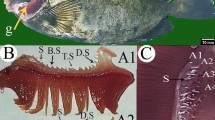Abstract
A comparative analysis of fatty acids (FA) in neutral lipids and phospholipids of digestive gland and pedal muscle has been performed in molluscs from various ecological groups differing by belonging to sea or fresh water, trophic types or the associated motor activity. In freshwater pulmonary gastropods Lymnaea stagnalis and Lymnaea ovalis and marine prosobranchial molluscs Buccinum undatum and Littorina littorea the total content of ω3-acids in phospholipids of the studied tissues differed more than twice, predominantly due to the combined effect of temperature and salinity of the habitat. The lower viscosity of cell membranes in marine species (ω3/ω6 < 1) is determined to the greatest degree by the presence of eicosapentaenoic acid that accounts for 22–25% of the FA sum in marine species. Comparison of the molluscs by their trophic belonging has revealed the presence of linoleic acid in triglycerides in digestive glands of phytophages (8–12%), but the practically complete absence of this acid in the predator B. undulatum (< 0.8%). By mobility, L. littorea inhabiting the high-low tide littoral was inferior to freshwater pulmonary gastropods and to the marine predator, as it stops moving twice a day during the low tide. In phospholipids of pedal muscle of this mollusc the amount of long-chain polyunsaturated C: 22 FA was 3–6 times lower than that in other studied species, which might possibly indicate the role of these acids in functioning of the pedal muscle contractile tissue. On the whole, use of the FA characteristics as the parameters determining belonging to certain ecological group requires a certain caution due to a complex action of biotic and abiotic factors on the animal metabolism. The exception is the ω3/ω6 ratio in total phospholipids of fresh water and marine gastropods.
Similar content being viewed by others
References
Belokopytin, Yu.S., Levels of Energy Metabolism in Adult Fish, Elementy fiziologii i biokhimii obshchego i aktivnogo obmena u ryb (Elements of Physiology and Biochemistry of General and Active Metabolism in Fish), Kiev, 1978, pp. 46–63.
Dykens, J.A. and Mangum, C.P., The Design of Cardiac Muscle and the Mode of Metabolism in Molluscs, Comp. Biochem. Physiol., 1979, vol. 62, pp. 549–554.
Houlihan, D.F. and Innes, A.J., Oxygen Consumption, Crawling Speeds, and Cost of Transport in Four Mediterranean Intertidal Gastropods, J. Comp. Physiol., 1982, vol. 147B, pp. 113–121.
Newell, R.G. and Northcroft, H.R., A Re-Interpretation of the Effect of Temperature on the Metabolism of Certain Marine Invertebrates, J. Zool., 1967, vol. 151, pp. 277–298.
Calow, P., Some Observations on Locomotory Strategies and Their Metabolic Effects in Two Species of Freshwater Gastropods, Ancylus fluviatilis MЬll., and Planorbis contortus Linn., Oecologia, 1974, vol. 2, pp. 149–161.
Abolmasova, G.I., Shchepkina, A.M., and Yuneva, T.V., Energetic Peculiarities of Squids, Bioenergetika gidrobiontov (Bioenergetics of Hydrobionts), Kiev, 1990, pp. 83–101.
Gudimov, A.V., Measurement of Rate of Oxygen Consumption by Mussels (Mytilus edulis L.) under Aquarial Conditions, Troficheskie vzaimootnosheniya organizmov bentosa i donnykh ryb Barentseva morya (Trophic Interrelations of Benthic Organisms and Bottom-Living Fish of the Barents Sea), Apatity, 1989, pp. 96–103.
Alimov, A.F., Funktsional'naya ekologiya presnovodnykh dvustvortchatykh mollyuskov (Functional Ecology of Freshwater Bivalve Molluscs), Leningrad, 1981.
Bishop, T., Ocloo, A., and Brand, M.D., Structure and Function of Mitochondria in Hepatopancreas Cells from Metabolically Depressed Snails, Physiol. Biochem. Zool., 2002, vol. 75, pp. 124–144.
Folch, J., Lees, M., and Sloan-Stenley, G., A Simple Method for the Isolation and Purification of Total Lipids from Animal Tissues, J. Biol. Chem., 1957, vol. 226, pp. 497–509.
Arakelova, E.S., Intensity of Metabolism in Gastropod Molluscs, Morfologicheskie i ekologicheskie osnovy sistematiki mollyuskov (Morphological and Ecological Grounds for Molluscs Taxonomy), Trudy ZIN Akad. Nauk SSSR, 1986, vol. 148, pp. 71–85.
Arakelova, E.S., The Influence of Food Quality on the Consumption Rate in Freshwater Snails, Russ. J. Aquat. Ecol., 1993, vol. 2, pp. 13–22.
Golikov, A.N., Fauna SSSR. Mollyuski (Fauna of the USSR. Molluscs), vol. 5, iss. 2, Leningrad, 1980.
Berger, V.Ya., Euryhalinity of Marine Molluscs: Morphological and Functional Aspects, Fiziologiya i biokhimiya adaptatsii morskikh zhivotnykh (Physiology and Biochemistry of Adaptation of Marine Animals), Vladivostok, 1981, pp. 91–99.
Colaço, A., Desbruyères, D., and Guezennec, J., Polar Lipid Fatty Acids as Indicators of Trophic Associations in a Deep-Sea Vent System Community, Mar. Ecol., 2007, vol. 28, pp. 15–24.
Arakelova, E.S., Total Lipid Composition and the Energy Metabolism Rate in Gastropod Molluscs, Zh. Obshch. Biol., 2008 (in press).
Shulman, G.E., Ostolovskii, E.M., Shershov, S.V., and Kryachko, V.I., Phospholipid Composition of the Black Sea Fish, Bioenergetika gidrobiontov (Bioenergetics of Hydrobionts), Kiev, 1990, pp. 189–196.
Chatelier, A., McKenzie, D.J., Prinet, A., Galois, R., Robin, J., Zambonino, J., and Claireaux, G., Associations between Tissue Fatty Acid Composition and Physiological Traits of Performance and Metabolism in the Sea Bass (Dicentrarchus labrax), J. Exp. Biol., 2006, vol. 209, pp. 3429–3439.
Khardin, A.S., Aizdaicher, N.A., and Latyshev, N.A., Changes in Fatty Acid Composition in Mollusc Mytilus edulis, Associated with Feeding with Microalgae, V Regional'naya konferentsiya po aktual'nym problemam ekologii, morskoi biologii i biotekhnologii (V Regional Conference on Actual Problems of Ecology, Marine Biology, and Biotechnology), Vladivostok, 2002, pp. 119–121.
Else, P.L., Turner, N., and Hulbert, A.J.R., The Evolution of Endothermy: Role for Membranes and Molecular Activity, Physiol. Biochem. Zool., 2004, vol. 77, pp. 950–958.
Author information
Authors and Affiliations
Additional information
Original Russian Text © E. S. Arakelova, M. A. Chebotareva, S. A. Zabelinskii, V. P. Ivanova, 2009, published in Zhurnal Evolyutsionnoi Biokhimii i Fiziologii, 2009, Vol. 45, No. 1, pp. 46–52.
Rights and permissions
About this article
Cite this article
Arakelova, E.S., Chebotareva, M.A., Zabelinskii, S.A. et al. Effect of habitat and motor activity of molluscs on fatty acid composition of triglycerides and phospholipids. J Evol Biochem Phys 45, 51–58 (2009). https://doi.org/10.1134/S0022093009010049
Received:
Published:
Issue Date:
DOI: https://doi.org/10.1134/S0022093009010049




